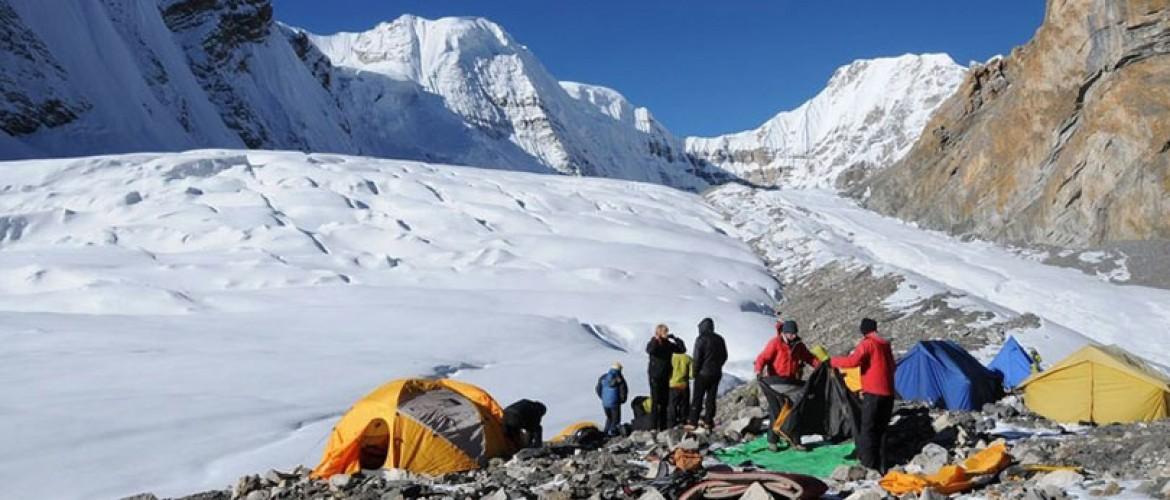
Saribung Peak Climbing
SARIBUNG PEAK CLIMBING OVERVIEW
Saribung Peak Climbing or Saribung Expedition is truly an off-the-beaten-path excursion, which adds to its new, untamed, allure, and mystique location, where few people go. This journey is newer and more interesting than many others with a climb up to the magnificent Saribung Peak (6346 m) that lies near the Damodar Mountain Range in a remote section of Mustang and a stone's throw from the Tibetan border.
This is considered a challenging expedition that takes you over an otherworldly landscape of sculpted canyons, surreal rock formations, medieval villages, ruined fortresses, Tibetan Buddhist gompas, soaring snow peaks, and distinct Himalayan cultures. Upper Jomsom, the restricted region of Upper Mustang, strikingly beautiful Nar Phu Valley, and the lonely Hidden Valley are all included in one excellent adventure.
In addition, this newly discovered trekking route crosses challenging Saribung Pass (6042 m), which is one of the highest passes in Nepal. The trail to the pass is surely not easy, but the views you will get to see from the top of this pass are truly rewarding. You will be rewarded with breathtaking views of Himlung Himal (7126m), Nilgiri Himal (7061m), Lamjung Himal (6983m), Mt. Manaslu (8163m), and Annapurna II (7937m) from the summit of Saribung Peak.
The region is also part of the Annapurna Conservation Area, Nepal's largest protected area and home to Mt. Dhaulagiri (8167m), the world's seventh highest mountain. Tukuche Peak (6920m), Nilgiri South (6839m), Yakwakang Peak (6462m), and Damodar Himal (6004m) are among the 6000m+ peaks in the area.
Hence, Saribung Peak Climbing is certainly a once-in-a-lifetime journey that includes mythological sites, wild and remote locations, spectacular pass crossings, special trek, and one-of-a-kind trips.
Saribung Peak Climbing Trip Highlights
- Discover an isolated part of the Mustang region that lies within the Damodar Himal Range
- Trekking experience through low sub-tropical woods to high alpine rocky terrain
- Upper Jomsom, Upper Mustang, isolated Nar Phu Valley, and Hidden Valley in one excellent adventure
- Get the insights into Tibetan like environment, culture, and people
- Face the challenges of not only climbing Saribung Peak at 6,328m but also traversing the 6,042m Saribung La pass
- Wonderful views of Dhaulagiri, Manaslu, and the Annapurna range
- Take in the striking vistas of Himlung Himal, Nilgiri Himal, Lamjung Himal, Mt. Manaslu, and many other peaks
Difficulty Level of Saribung Expedition
Saribung Peak Expedition is not a technical climb, but it is considered a difficult excursion due to the altitude change and isolation of the location. With the challenging routes and off-the-beaten paths linked with Saribung Peak, this journey is where you will be ascending to a staggering height of 6,328 meters.
Between the Damodar Kunda (lake) and the Nar-Phu valley, there are numerous passes with ice and crevasses. Two of the most notable challenges are the Kang La high pass and Saribung La pass, which is located above 5200 meters. For the most part, these will necessitate glacier travel mode, with only a few portions of fixed-line requiring the use of a jumar. As a result, climbing the Saribung Peak necessitates a basic understanding of mountaineering methods excellent physical shape, and a lot of determination.
Trekkers must walk an average of 6 to 7 hours per day off-trail or over tough terrain, with a total elevation gain of more than 1000 meters or 20 kilometers. And, if you are an experienced mountaineer, ascending Saribung Peak will be quite easy for you.
Altitude Mountain Sickness (AMS) during Saribung Peak Climbing
The well-planned Saribung Peak Climbing itinerary includes two practical and beneficial acclimatization days and pre-climb training which helps in the adaption of the thin air and reduces the chance of mountain sickness.
However, to avoid getting AMS, we recommend that you stay hydrated and walk at a relaxed pace. If any symptoms are seen, immediately inform the guides as our guides are always equipped with a first-aid kit and a pulse oximeter (which measures the amount of oxygen in your blood). Every one of our mountain commanders is experienced, smart, and insightful and can deal with any health risks or unforeseen occurrences.
Best time to do the Saribung Peak Climbing
Saribung Peak climbing is best done in the spring (March to May) and autumn (mid-September to November).
During these seasons, the weather is pleasant, providing perfect circumstances for hiking and climbing with less snow and clear mountain vistas.
Monsoon and winter are considered off-seasons, and climbing during these times is not recommended due to wet, slippery trails and unsatisfying vistas and heavy snowfall and extreme cold.
Permits for Saribung Peak Climbing
- Saribung Peak Climbing needs the following permissions:
- Immigration Documentation and Permits for Saribung Expedition
- Saribung Peak climbing fees/Royalty
- TIMS (Trekkers’ Information Management System)
- ACAP (Annapurna Conservation Area Permit)
- Upper Mustang Special Permit